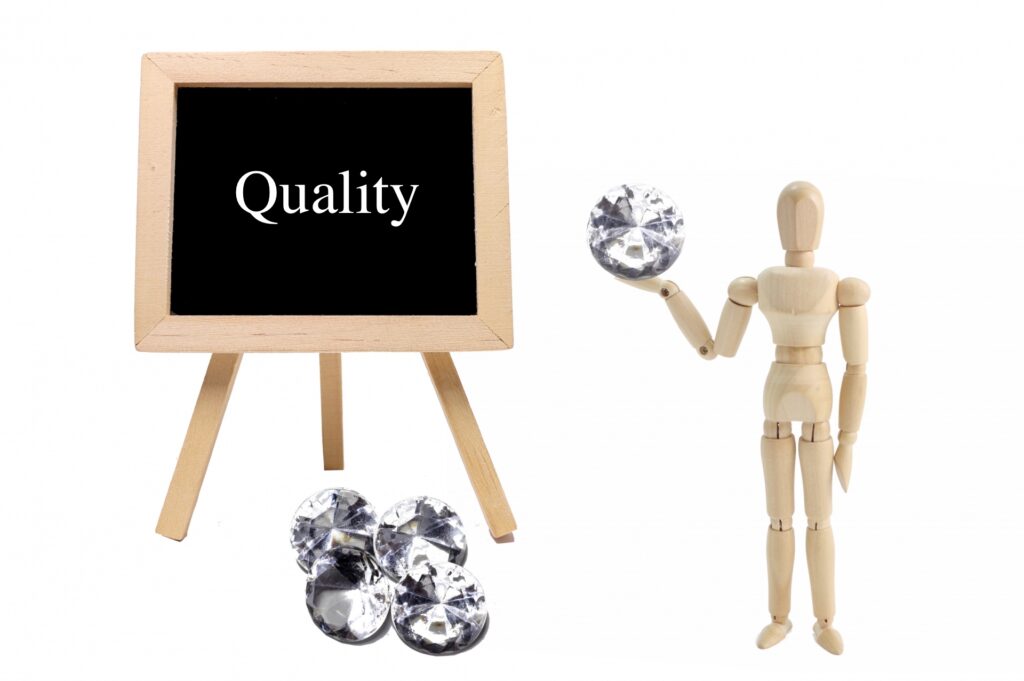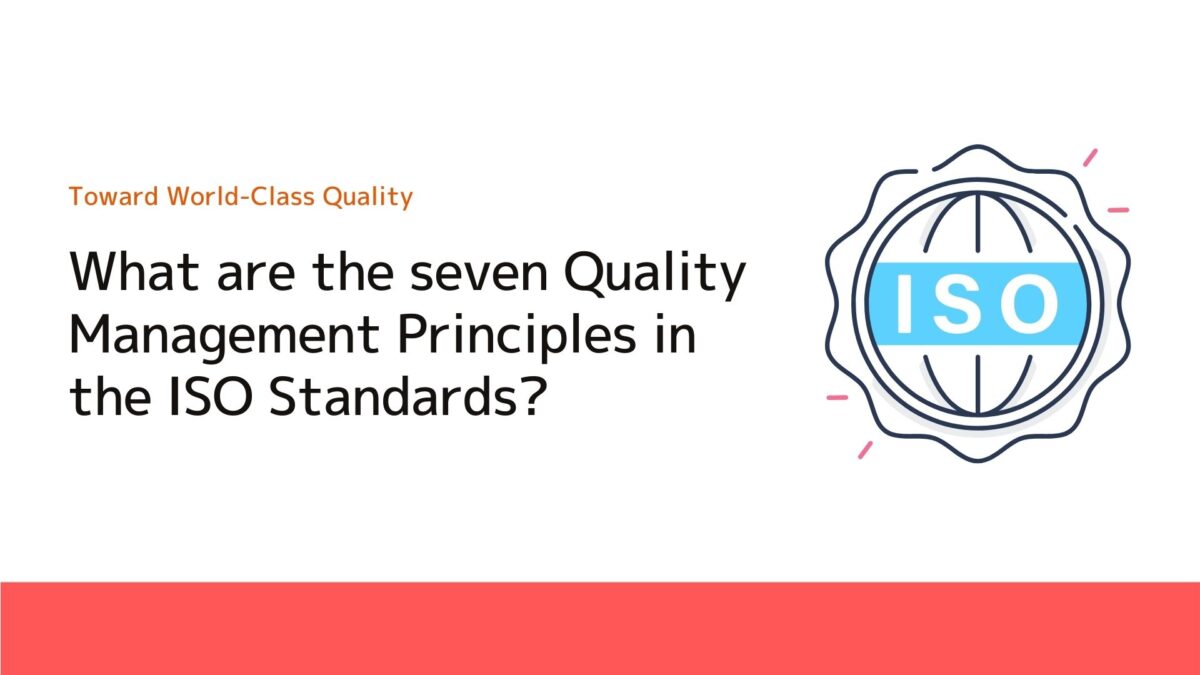ISO stands for International Organization for Standardization. It is a non-governmental organization which holds its headquarters in Geneva, Switzerland. Currently, it has 165 member countries including Japan.
ISO establishes and authorizes international standards for products and services. By obtaining the ISO certification, it is possible for enterprises to provide products and services anywhere in the world.
Not only that, but ISO standards also authorizes management systems used to control the quality management and environmental activities of companies.
The ISO 9000 series for quality management is a standard established to properly operate a quality management system that should be implemented in the provision of products and services.
The ISO 9001, part of the ISO 9000 series is aimed at the continuous quality improvement of products and services. When a company receives ISO 9001 certification, it assures that the company holds a system which meets global standards.

Seven principles of quality management
In Japan, the Japanese Industrial Standard (JIS) acts as a standard for products and services. The “JIS Q 9001:2015 Quality Management Systems – Fundamentals and Terminology”, based on the ISO 9000 and established by JIS, defines the following seven principles for quality management:
Customer Focus
The focus of quality management is to meet the requirements of customers and to strive to exceed their expectations.
“JIS Q 9001:2015 Quality Management Systems – Fundamentals and Terminology (2.3.1 Customer Focus)”
Organizations, including companies, are required not only to understand and satisfy the requirements of their current customers, but also to continue to strive to exceed their customers’ expectations in the future.
The term “customers” in the article includes both end users and internal customers. Internal customers are people in charge within the organization, who are involved in the supply of products and services. Customer focus is the most important principle in ISO 9001.
Leadership
Leaders at all levels should align the organization’s objectives and direction, and maintain a situation in which people are actively involved in achieving the organization’s quality goals.
“JIS Q 9001:2015 Quality Management Systems – Fundamentals and Terminology (2.3.2 Leadership)”
The ISO 9001 underscores that the responsibility for quality management rests on the leaders of the organization. Leaders are expected to take the initiative in establishing and implementing the quality management system, evaluating the effectiveness of the system, and making improvements.
In the ISO 9001, the direction of the organization is determined by the quality policy articulated by the top management. It is important that the quality policy is informed both internally and externally, in order to establish clear communication to the workers and to obtain the trust of customers.
In the ISO standard, the word “effectiveness” is frequently used. Effectiveness means not only the existence of mechanisms and rules, but also that they are functioning properly to achieve the objectives.
Engagement of People
Competent, empowered, and active participants at all levels within the organization are essential to strengthening the organization’s ability to create and deliver value.
“JIS Q 9001:2015 Quality Management Systems – Fundamentals and Terminology (2.3.3 Engagement of People)”
Quality management is not something that is done only by the top managers. The entire organization is required to participate in the system in accordance with the top managers’ “Quality Policy”. The top managers must clarify the roles and authority of the organization, and consider what the constituents should do to achieve the goal of increasing customer satisfaction and implement it.
The organization is required to appropriately evaluate the competence of its members and systematically work to improve each member’s competence.
The word “competence” used in the ISO standard refers to the skills and qualifications of each member.
ISO 9001 requires organizations to correctly determine and manage the competence of its members. It is important that appropriate tasks are assigned to members who have a certain level of competence or higher.
Process Approach
By understanding and managing activities as interrelated processes that function as a coherent system, consistent and predictable results can be achieved effectively and efficiently.
“JIS Q 9001:2015 Quality Management Systems – Fundamentals and Terminology (2.3.4 Process Approach)”
Process approach is used to manage the flow of work within an organization by small units. ISO 9001 emphasizes the importance of managing the flow of work. It must be periodically checked within the organization to see if there is any “wasteful work” or “areas for error” in the process.
By clarifying and improving the issues above, the quality of products and services could be improved. In order to do so, it is necessary to define the correct procedures and rules for a series of business processes.
Improvement
Successful organizations have a continual focus on improvement.
“JIS Q 9001:2015 Quality Management Systems – Fundamentals and Terminology (2.3.5 Improvement)”
In order to improve quality according to the principle of “customer focus”, constant improvement is required. The PDCA (Plan-Do-Check-Action) cycle is as important as the customer focus in ISO 9001.
The PDCA cycle is an abbreviation for Plan→Do→Check→Action, and implementing the PDCA cycle leads to continuous improvement.

Evidence-Based Decision Making
Decisions based on the analysis and evaluation of data increase the likelihood of achieving the desired results.
“JIS Q 9001:2015 Quality Management Systems – Fundamentals and Terminology (2.3.6 Evidence-Based Decision Making)”
In order for an organization to meet its goals, it is necessary to analyze various data, determine objective facts, and make decisions based on the correct information.
Relying on personal experience and intuition of top management is not ideal. Companies must improve the management system based on objective data. Accumulating accurate data will enable companies to reach the target goals.
Relationship Management
Organizations manage its relationships with stakeholders for sustained success.
“JIS Q 9001:2015 Quality Management Systems – Fundamentals and Terminology (2.3.7 Relationship Management)”
Essentially, the positions of the organization and external stakeholders are equal. Focusing on the customer does not mean creating a one-sided master-slave relationship, but rather building a mutually beneficial relationship.
After building a beneficial relationship with customers, companies should continue to make efforts to increase customer satisfaction. It is also important for quality management to build good relationships with suppliers and related companies.
Conclusion
ISO 9001 certification cannot be obtained simply by meeting the requirements of the standard.
In order to be certified, you need to pass an audit that includes the effectiveness of your quality management system. Moreover, since the certification will be revoked if the audit is not passed periodically, efforts must be made to continuously operate the system appropriately.
In order to maintain the quality management system at an appropriate level, it is important to constantly implement the PDCA cycle. Deepening the understanding of the seven principles of ISO 9001 will surely enable organizations to establish a quality management system that meets global standards.
▼Citations
(Photos from PhotoAC)
Japan Quality Assurance Organization

